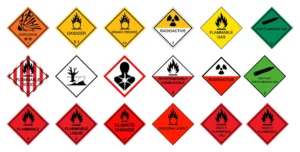How to Ship Dangerous Goods Internationally Safely in 2024
Introduction
Dangerous goods shipping requires strict compliance with international regulations to ensure safety during transport. Whether you’re shipping chemicals, batteries, or flammable liquids, understanding how to ship dangerous goods internationally is crucial. This 2024 guide covers key requirements, including UN packaging, IMDG/IATA rules, and proper documentation.
1. What Are Dangerous Goods? Understanding Hazard Classes (Class 1-9)
Dangerous goods shipping involves transporting materials that pose risks to health, safety, or the environment. These hazardous materials are classified into 9 categories under the UN system, each with specific international shipping requirements:
| Class | Hazard Type | Examples | Shipping Risks |
|---|---|---|---|
| Class 1 | Explosives | Fireworks, ammunition | Detonation risk |
| Class 2 | Gases | Propane, oxygen tanks | Pressure leaks, flammability |
| Class 3 | Flammable Liquids | Gasoline, ethanol | Fire hazard |
| Class 4 | Flammable Solids | Sulfur, magnesium | Spontaneous combustion |
| Class 5 | Oxidizers & Organic Peroxides | Hydrogen peroxide, fertilizers | Chemical reactions |
| Class 6 | Toxic & Infectious Substances | Pesticides, medical waste | Poisoning contamination |
| Class 7 | Radioactive Materials | Uranium, medical isotopes | Radiation exposure |
| Class 8 | Corrosives | Sulfuric acid, batteries | Metal/body tissue damage |
| Class 9 | Miscellaneous Hazards | Lithium batteries, dry ice | Thermal/chemical risks |
Why This Matters for Dangerous Goods Shipping?
✔ Proper classification ensures compliance with international transport regulations (IATA/IMDG/ADR).
✔ Mislabeling (e.g., shipping Class 3 liquids as general cargo) can lead to fines or accidents.
✔ Specialized packaging is required per class (e.g., UN-certified drums for Class 3, shielded containers for Class 7).
2. How to Ship Dangerous Goods Internationally: Key Regulations
Shipping dangerous goods internationally requires compliance with:
a) IATA (Air Transport)
UN-certified packaging
Proper labeling (Class labels, UN numbers)
Dangerous Goods Declaration (DGD)
b) IMDG (Sea Freight)
Segregation rules
Special stowage requirements
Container testing standards
c) ADR/RID (Road/Rail)
Driver training & vehicle safety checks
Route restrictions for hazardous cargo
3. Dangerous Goods Packaging & Labeling Requirements
Proper hazardous materials shipping requires:
✔ UN-approved containers (drums, jerricans)
✔ Leak-proof & impact-resistant packaging
✔ Correct hazard labels (Class 3, 8, 9, etc.)
✔ Shipping name & UN number (e.g., UN 1170 for ethanol)
4. Documentation for International Dangerous Goods Shipping
Required documents include:
Safety Data Sheet (SDS)
Dangerous Goods Declaration (DGD)
UN certification for packaging
Country-specific permits (e.g., PH customs for chemicals)
5. Common Mistakes in Dangerous Goods Logistics
Avoid these errors when shipping hazardous materials:
❌ Incorrect classification (wrong UN number)
❌ Improper labeling (missing hazard diamonds)
❌ Insufficient packaging (non-UN certified)
❌ Missing documentation (no DGD or SDS)
6. How to Choose a Reliable Dangerous Goods Shipping Provider?
Key factors:
✅ Certified in IATA/IMDG/ADR
✅ Experience with your cargo type
✅ Global network for smooth customs clearance
Conclusion
Mastering dangerous goods shipping ensures safe and compliant transport. Follow these steps on how to ship dangerous goods internationally to avoid fines and delays. For expert assistance, consult a certified DG logistics provider.
Additional Resources:
